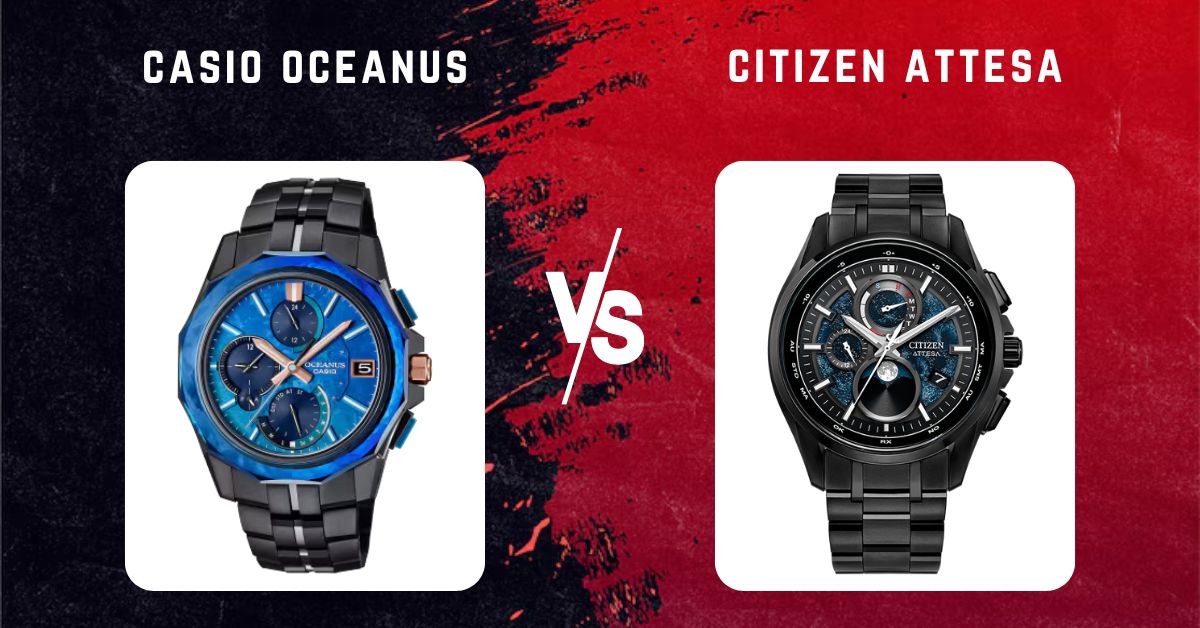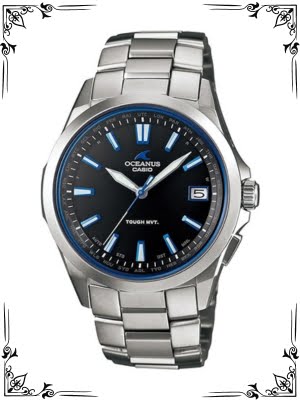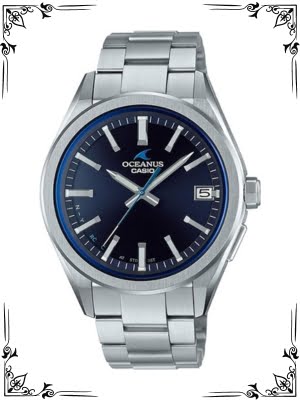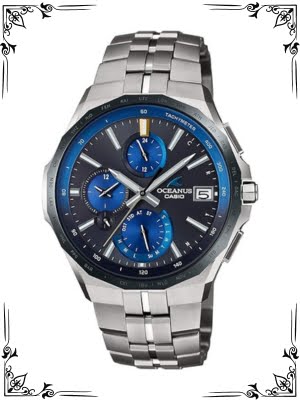Casio Oceanus: Premium materials, radio-controlled timekeeping, advanced features, diverse style options, and often higher price points. Citizen Attesa: Eco-Drive solar technology, satellite wave timekeeping, focus on comfort and legibility, competitive price range.
Introduction
In the realm of high-tech, solar-powered watches, two prominent names emerge Casio Oceanus and Citizen Attesa. Both boast advanced features, sleek designs, and a commitment to sustainability. But which one reigns supreme on your wrist?
This in-depth guide delves into their history, technical specifications, design elements, and user feedback to help you choose your champion.
Unveiling Their History
Casio Oceanus: Launched in 1989, Oceanus represents Casio’s premium line, known for pushing boundaries in technology and design. Their commitment to radio-controlled timekeeping ensures ultimate accuracy, while their use of high-quality materials like titanium and sapphire crystal elevates the Oceanus experience.
Citizen Attesa: Debuting in 1996, Attesa embodies Citizen’s dedication to advanced technology within a user-friendly package. The focus on Eco-Drive solar technology aligns with Citizen’s commitment to eco-consciousness, while their satellite wave functionality guarantees unmatched timekeeping precision.
Technical Breakdown
Now, let’s delve deeper into the technical specifications of these two contenders:
Movement
At the heart of the watch, the movement dictates accuracy, power reserve, and available features.
Casio Oceanus: Utilizes a variety of quartz movements, some featuring Casio’s proprietary Multi-Band 6 Atomic Clock Synchronization. This technology ensures the watch automatically adjusts to the nearest atomic clock signal, guaranteeing near-perfect timekeeping accuracy.
Citizen Attesa: Primarily employs Eco-Drive solar movements that convert light into electricity, eliminating the need for battery replacements. Some Attesa models also boast Satellite Wave Timekeeping, automatically synchronizing with orbiting satellites for unmatched global time precision.
Table 1: Movement Comparison
| Feature | Casio Oceanus | Citizen Attesa |
|---|---|---|
| Movement Type | Quartz (Various) | Eco-Drive (Solar Quartz) |
| Timekeeping Technology | Multi-Band 6 Atomic Clock Sync (Some Models) | Satellite Wave Timekeeping (Some Models) |
Materials and Construction
The materials used in a watch impact its durability, weight, and overall aesthetic.
Casio Oceanus: Known for premium materials like Super Titanium (a lightweight and highly scratch-resistant titanium alloy), sapphire crystal, and ceramic bezels. This combination translates to a luxurious and robust build quality.
Citizen Attesa: Utilizes stainless steel for cases and bracelets, with sapphire crystal on some models. While not quite as lightweight as Super Titanium, stainless steel is a reliable and durable material. The focus leans toward practicality and comfort.
Table 2: Construction and Features Comparison
| Feature | Casio Oceanus | Citizen Attesa |
|---|---|---|
| Case Material | Super Titanium (Some Models), Stainless Steel | Stainless Steel |
| Crystal | Sapphire (Most Models) | Sapphire (Some Models) |
| Bezel | Stainless Steel, Ceramic (Some Models) | Stainless Steel |
| Functions | Timekeeping, Date, Chronograph (Some Models), World Time, etc. | Timekeeping, Date, Chronograph (Some Models), World Time, etc. |
| Water Resistance | Varies (Up to 200 meters) | Varies (Up to 200 meters) |
Functions and Features
Both Oceanus and Attesa offer a range of functionalities beyond basic timekeeping:
Timekeeping: Both excel in this core function, with radio-controlled or satellite wave technology ensuring unmatched accuracy.
Date: Most models display the date window for added convenience.
Chronograph: Some models feature chronograph functions for measuring elapsed time.
World Time: Allows for easy tracking of time across different time zones.
Additional Features: Casio Oceanus might offer additional features like a low battery indicator, perpetual calendar, and moon phase depending on the specific model. Citizen Attesa might have features like a power reserve indicator and alarm depending on the model.
Water Resistance
Both Casio Oceanus and Citizen Attesa offer a range of water resistance ratings, catering to different activities:
Water Resistance: Both offer models ranging from 30 meters (3 ATM) for basic splash resistance to 200 meters (20 ATM) suitable for swimming and diving. Choose the water resistance level that best suits your needs.
Power Source
Casio Oceanus: Relies on traditional batteries for some models, while others utilize solar-assisted charging. The battery life can vary depending on the model and usage patterns.
Citizen Attesa: Utilizes Eco-Drive solar technology as its primary power source. This innovative technology converts light from any source into electricity, eliminating the need for battery replacements. As long as the watch receives sufficient light exposure, it will continue to function.
Design and Aesthetics
The visual appeal of a watch is a subjective experience. Here’s a breakdown of the design elements that distinguish Casio Oceanus and Citizen Attesa:
Dial Design
Casio Oceanus: Offers a variety of dial designs, ranging from sporty and functional to elegant and sophisticated. Some models boast intricate details and multi-layered textures, while others prioritize clean and legible layouts.
Citizen Attesa: Leans towards a more minimalist and functional aesthetic. Dials are typically well-organized and easy to read, with a focus on clarity and practicality.
Case and Bezel
Casio Oceanus: Features a wide range of case sizes and styles, from bold and chunky to sleek and slim. Bezels can be crafted from stainless steel, ceramic, or even titanium, adding a touch of luxury and functionality.
Citizen Attesa: Primarily offers cases in a more moderate size range, emphasizing comfort and wearability. Bezels are typically crafted from stainless steel, complementing the overall streamlined aesthetic.
Clasp & Bracelet
Casio Oceanus: Offers a variety of straps and bracelets, including metal bracelets, rubber straps, and leather straps. This allows for customization based on style and activity level.
Citizen Attesa: Primarily utilizes metal bracelets focusing on comfort and durability. Some models might offer additional strap options, but the selection is generally more limited than Oceanus.
Brand Image
Casio Oceanus: Represents Casio’s premium line, known for pushing technological boundaries and offering diverse features and styles. They cater to a wider audience, from tech enthusiasts to those seeking a luxurious timepiece.
Citizen Attesa: Embodies Citizen’s commitment to user-friendly technology and eco-consciousness. They focus on functionality, comfort, and solar-powered sustainability, appealing to individuals who prioritize practicality and environmental responsibility.
User Feedback
By delving into user reviews, we can gain valuable insights into the real-world experience with these watches:
Casio Oceanus:
Strengths: Users praise the premium build quality, advanced features, and a wide variety of styles to choose from. Radio-controlled timekeeping and advanced functionalities like perpetual calendar and moon phase are appreciated by those seeking a feature-rich watch.
Weaknesses: The price point can be a deterrent for some, and some users find the feature-rich dials overwhelming. Additionally, the reliance on batteries in some models might be inconvenient for those who prefer a solar-powered option.
Citizen Attesa:
Strengths: Users appreciate the comfortable wearability, clear and legible dials, and the eco-friendly nature of the Eco-Drive technology. Satellite wave timekeeping is a major perk for frequent travelers or those who demand ultimate accuracy. The competitive price range also makes them an attractive option.
Weaknesses: Some users might find the design options slightly limited compared to Oceanus. Additionally, the focus on functionality can lead to a less visually exciting design for those who prioritize aesthetics.
Common Problems
While both watches are known for their reliability, it’s essential to consider potential issues:
Casio Oceanus:
Battery Replacement: Models relying on batteries might require periodic replacements, which can be inconvenient for some users.
Feature Overload: The abundance of features might overwhelm some users who prefer a simpler watch experience.
Citizen Attesa:
Limited Design Options: The focus on functionality might result in a less diverse range of styles compared to Oceanus.
Scratch Resistance: While some models utilize sapphire crystal, stainless steel cases might be more susceptible to scratches compared to Casio’s Super Titanium models.
Choosing Your Champion
The choice between Casio Oceanus and Citizen Attesa hinges on your priorities:
Tech-Savvy Luxury: If you crave advanced features, premium materials, and a diverse range of styles, Casio Oceanus is the perfect fit. With radio-controlled timekeeping, intricate dials, and luxurious materials like Super Titanium, it caters to tech enthusiasts and those seeking a statement piece.
However, be prepared for a potentially higher price point and the need for occasional battery replacements in some models.
Eco-Friendly Functionality: For those who prioritize comfort, legibility, and eco-consciousness, Citizen Attesa shines. The Eco-Drive technology ensures a maintenance-free experience, while the satellite wave timekeeping guarantees unmatched accuracy.
The focus on functionality translates to a clean and comfortable design, making them ideal for everyday wear. However, the design options might be slightly limited compared to Oceanus, and the stainless steel construction might be less scratch-resistant than Casio’s Super Titanium.
Ultimately, the best choice is the watch that resonates most with you. Consider trying both on if possible, to gauge comfort, style, and how it wears on your wrist. This personal experience can help you make an informed decision.
Additional Factors to Consider:
Lifestyle: If you lead an active lifestyle and prioritize durability, Casio Oceanus’ Super Titanium models might be a better choice.
Light Exposure: If you spend a significant amount of time indoors, Citizen Attesa’s Eco-Drive technology ensures the watch will function even with limited light exposure.
Personal Style: Do you prefer a feature-rich, statement piece like some Oceanus models? Or a clean and functional design like most Attesa models?
Conclusion
Both Casio Oceanus and Citizen Attesa represent exceptional options in the realm of high-tech, solar-powered watches. By understanding their technical specifications, design nuances, user feedback, and potential issues, you’re well-equipped to choose the champion that complements your style and needs.
Remember, the perfect watch is a reflection of you – a timepiece that tells not only time but also your story.
FAQs
Casio Oceanus vs. Citizen Attesa: Which is more accurate?
Both Casio Oceanus (with Multi-Band 6) and Citizen Attesa (with Satellite Wave) offer exceptional accuracy due to their radio-controlled or satellite wave timekeeping technology.
Casio Oceanus vs. Citizen Attesa: Which is more durable?
Casio Oceanus models with Super Titanium cases offer superior scratch resistance compared to Citizen Attesa’s stainless steel cases. However, both are known for their overall durability.
Casio Oceanus vs. Citizen Attesa: Which has a better battery life?
Citizen Attesa, with its Eco-Drive technology, eliminates the need for battery replacements altogether as long as it receives sufficient light exposure. Casio Oceanus models with solar-assisted charging offer extended battery life, but some models rely on traditional batteries that require periodic replacements.
Casio Oceanus vs. Citizen Attesa: Which is more expensive?
Casio Oceanus models can range from a competitive price point to a premium cost depending on features and materials. Citizen Attesa generally falls within a more competitive price range.
Casio Oceanus vs. Citizen Attesa: Which brand is better?
There’s no single “better” brand. Both Casio Oceanus and Citizen Attesa are reputable brands with a strong heritage in watchmaking. The choice depends on your priorities for features, materials, design, and budget.




